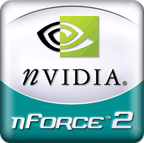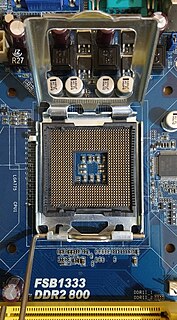Related Research Articles

PCI Express, officially abbreviated as PCIe or PCI-e, is a high-speed serial computer expansion bus standard, designed to replace the older PCI, PCI-X and AGP bus standards. It is the common motherboard interface for personal computers' graphics cards, hard disk drive host adapters, SSDs, Wi-Fi and Ethernet hardware connections. PCIe has numerous improvements over the older standards, including higher maximum system bus throughput, lower I/O pin count and smaller physical footprint, better performance scaling for bus devices, a more detailed error detection and reporting mechanism, and native hot-swap functionality. More recent revisions of the PCIe standard provide hardware support for I/O virtualization.

The southbridge is one of the two chips in the core logic chipset on a personal computer (PC) motherboard, the other being the northbridge. The southbridge typically implements the slower capabilities of the motherboard in a northbridge/southbridge chipset computer architecture. In systems with Intel chipsets, the southbridge is named I/O Controller Hub (ICH), while AMD has named its southbridge Fusion Controller Hub (FCH) since the introduction of its Fusion AMD Accelerated Processing Unit (APU) while moving the functions of the Northbridge onto the CPU die, hence making it similar in function to the Platform hub controller.

The nForce2 chipset was released by Nvidia in July 2002 as a refresh to the original nForce product offering. The nForce2 chipset was a platform for motherboards supporting AMD's Socket A CPUs along with DDR SDRAM. There were variations of the chipset including one with and one without an integrated GeForce4 MX graphics processor (IGP).

LGA 775, also known as Socket T, is an Intel desktop CPU socket. Unlike earlier common CPU sockets, such as its predecessor Socket 478, the LGA 775 has no socket holes; instead, it has 775 protruding pins which touch contact points on the underside of the processor (CPU).

The nForce4 is a motherboard chipset released by Nvidia in October 2004. The chipset supports AMD 64-bit processors and Intel Pentium 4 LGA 775 processors.

Scalable Link Interface (SLI) is a brand name for a multi-GPU technology developed by Nvidia for linking two or more video cards together to produce a single output. SLI is a parallel processing algorithm for computer graphics, meant to increase the available processing power.

The nForce3 chipset was created by Nvidia as a Media and Communications Processor. Specifically, it was designed for use with the Athlon 64 processor.
The Radeon Xpress 200 is a computer chipset released by ATI. The chipset supports AMD 64-bit processors as well as supporting Intel Pentium 4, Pentium D and Celeron processors. Additionally, it includes support for DDR400 RAM and DDR-2 667 RAM on the Intel Edition.
The nForce 500 is a motherboard chipset series and the successor to the nForce4 series. It was revealed by NVIDIA on 2006-03-07 and released on May 23, 2006. The nForce 500 series supports AMD's Socket AM2 and support for Intel's LGA 775 has also been added.
The Xpress 3200 is a new revision of the Xpress 200 computer chipset released by ATI. The chipset supports AMD64 processors for Socket 939 and Socket AM2.
The AMD Quad FX platform is an AMD platform targeted at enthusiasts which allows users to plug two Socket F Athlon 64 FX or 2-way Opteron processors (CPUs) into a single motherboard for a total of four physical cores. This is a type of dual processor setup, where two CPUs are installed on a motherboard to increase computing power. The major difference between the platform and past dual processor systems like Xeon is that each processor has its own dedicated memory stores. The Quad FX platform also has HyperTransport capability targeted toward consumer platforms.
AMD 580 chipset series is a computer chipset series designed by the AMD Graphics Product Group, for the AMD processors. It was designed for usage with ATI's CrossFire Multi GPU Technology, with both PCI Express slots running at x16 lanes each.
The AMD 700 chipset series is a set of chipsets designed by ATI for AMD Phenom processors to be sold under the AMD brand. Several members were launched in the end of 2007 and the first half of 2008, others launched throughout the rest of 2008.
Intel's Skulltrail is an enthusiast gaming platform that was released on February 19, 2008. It is based on the company's 5400 "Seaburg" workstation chipset. The primary difference between Skulltrail and Intel's current and past enthusiast chipsets is a dual CPU socket design that allows two processors to operate on the same motherboard. Therefore, Skulltrail can operate eight processing cores on one system. The platform supports two Core 2 Extreme QX9775 processors, which operate at 3.2 GHz.
I/O Controller Hub (ICH) is a family of Intel southbridge microchips used to manage data communications between a CPU and a motherboard, specifically Intel chipsets based on the Intel Hub Architecture. It is designed to be paired with a second support chip known as a northbridge. As with any other southbridge, the ICH is used to connect and control peripheral devices.
The nForce 700 is a chipset series designed by Nvidia first released in December 2007. The series supports both Intel Core 2 and AMD Phenom processors, and replaces the nForce 600 series chipsets. Several members were spotted, including the codenamed MCP72 for AMD processors and the C72 for Intel processors, launched with the name "nForce 780a" and "nForce 780i" chipsets respectively. Currently, the released variants are the 750i, 780i, 790i, and 790i Ultra.
The AMD 800 chipset series is a set of chipsets developed by AMD, released in 2009. The chipset series was revealed in its presentation slides during the AMD Financial Analyst Day 2007 held on December 13, 2007. This chipset series also marks the return of AMD to the workstation/server market after the completion of the ATI acquisition in October 2006 with the first server chipsets.
The Intel X79 is a Platform Controller Hub (PCH) designed and manufactured by Intel for their LGA 2011 and LGA 2011-1.

The AMD 900 chipset series is identical to the AMD 800 chipset series except for the fact that it is only found on Socket AM3+ mainboards, whereas its predecessor is only found on Socket AM3 mainboards. It was released in 2011.

On June 26, 2007, Dell released the new Inspiron desktop series as a replacement to the Dell Dimension desktop computers.
References
- ↑ "Tom's Hardware Guide review (page 5)". Tom's Hardware.
- ↑ "DailyTech report".
- ↑ "HKEPC report".
- ↑ "Archived copy". Archived from the original on 2007-01-03. Retrieved 2006-12-30.CS1 maint: archived copy as title (link)
- ↑ "Archived copy". Archived from the original on 2007-01-23. Retrieved 2007-01-21.CS1 maint: archived copy as title (link)